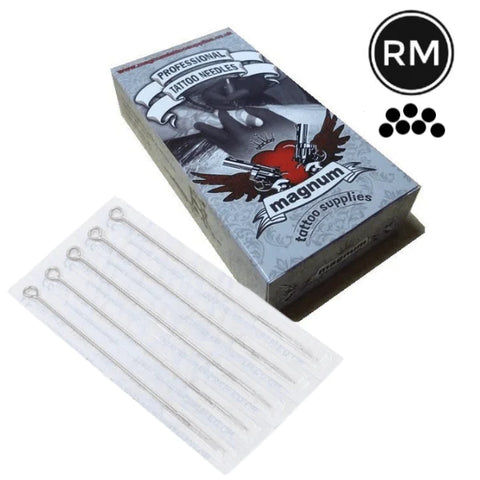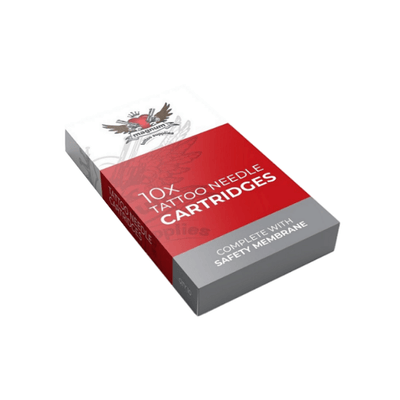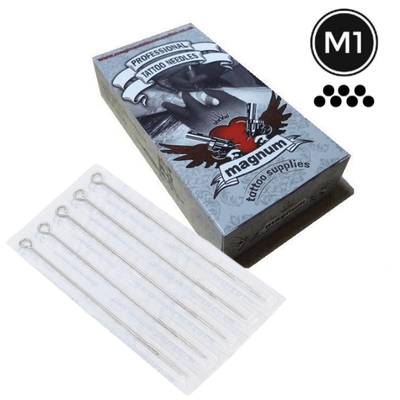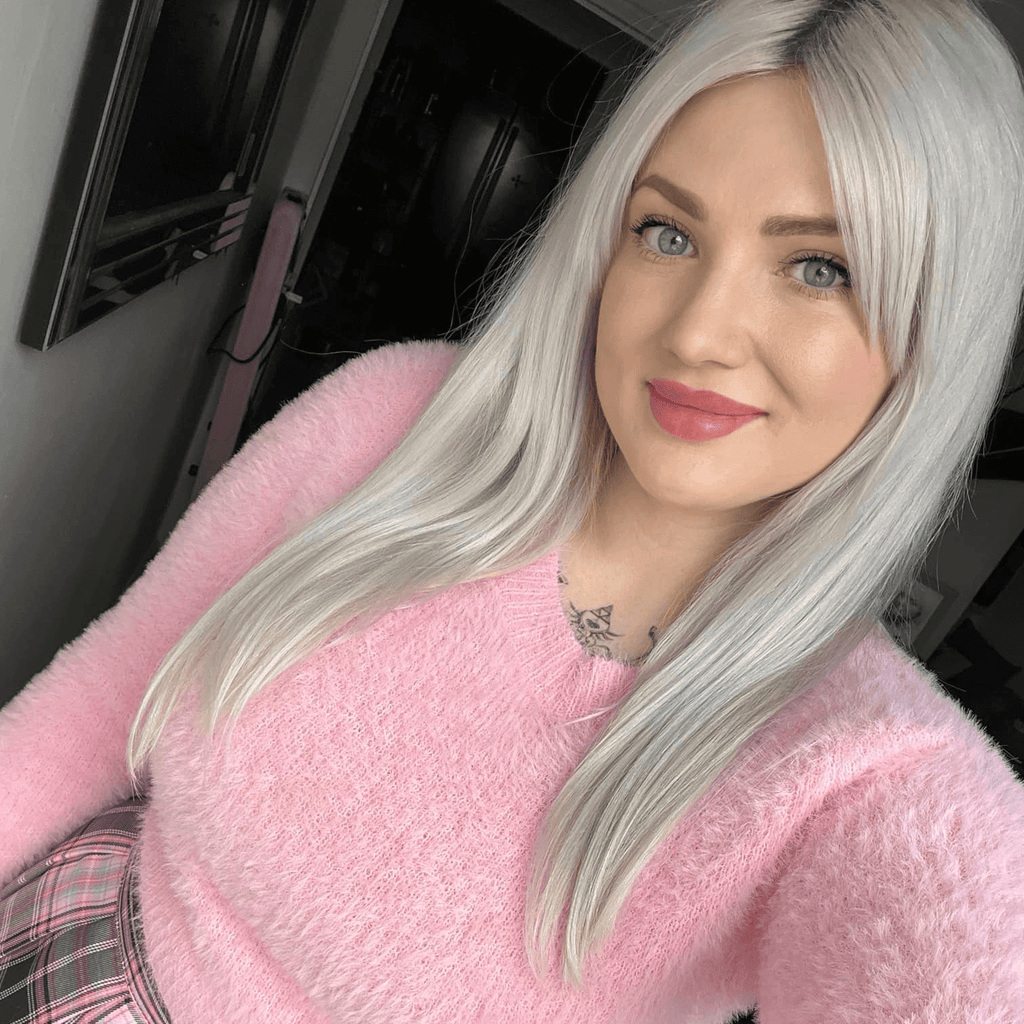Imagine spending hours refining a tattoo design for your client or yourself, only to realise midway that you've been using the wrong needle size. Not only can this mistake disrupt the final outcome, but it can also cause unnecessary pain or even damage to the skin.
For every tattoo artist, whether novice or seasoned, the process of selecting the right needle is as crucial as mastering the art of inking. But with a plethora of sizes, types, and brands available, how does one make an informed decision?
The fear of making errors, wasting valuable resources, or compromising a design due to a lack of knowledge is real. Dive into this comprehensive guide, where we'll break down tattoo needle sizes and their specific uses and help demystify the complexities behind this essential tool.
What are tattoo needles?
Tattoo needles are specialised needles used in tattoo machines to inject ink into the skin. They are made of stainless steel and come in various configurations and sizes for different types of lines, shading, and colour packing. The number of points, their arrangement, and their diameter determine the type of work the needle is suitable for.
Types of tattoo needles
Round Liner (RL)
Round Liner needles, commonly abbreviated as RL, are a staple in the tattoo industry. These needles are configured in a tight, circular pattern to deliver ink in a precise and controlled manner.
Round Liner tattoo needles are the go-to choice for fine line work, outlining intricate designs, and creating distinct edges. Whether you're working on dot work, traditional, or geometric styles, RL needles can achieve sharp and clean lines effortlessly.
Hollow Liner
Hollow Liner needles are an interesting variant. Instead of being tightly packed together, the needles are arranged to form a hollow circle at the centre.
Perfect for producing bold, consistent lines, Hollow Liners are often used in tribal designs and other work that requires substantial, continuous lines. If you're interested in hollow liners, check out these Empty Round Liner Kwadron Cartridges today.
Round Shader (RS)
Round Shader (RS) needles are another shading-focused variant. Set in a circular configuration similar to Round Liner needles, RS needles can have varying pin densities depending on the manufacturer.
Used mainly for shading and colour fills, RS needles are versatile enough to be used for thick line work as well, making them a multifunctional choice.
Flat Shader needles
Flat Shader needles are just what they sound like—pins soldered in a straight line on the bar. This linear configuration provides a unique ink flow.
Because they can deliver a significant amount of ink in a single pass, Flat Shaders are great for geometric patterns, mandala work, and even semi-permanent makeup.
Double-Stack Magnum Shader needles
For those seeking a more concentrated ink dispersion, Double Stack Magnum Shader needles offer tightly packed pins in two layers.
This configuration is primarily used for intricate shading and colour packing. The tighter pin arrangement allows for a more detailed colour distribution, ideal for realistic works.
Weaved Magnum
Weaved Magnum needles are designed with interleaved or woven pins, where every second needle is slightly raised, facilitating better ink flow.
These needles are best for large-scale shading, blending, and colour packing, providing excellent ink flow and distribution across a wide area.
Stacked Magnum
Stacked Magnums take the standard magnum configuration and bring the pins even closer together for a stacked, dense layout.
These are designed for detailed shading work where a tighter, more concentrated ink dispersion is needed, such as in photorealistic tattoos.
Curved/Round Magnum
Curved Magnums, also known as soft edge magnums, these needles feature pins that arch or curve at the centre, reducing skin trauma and offering a softer touch.
Ideal for soft shading, colour transitions, and blending curved or round magnums provide a softer application, making them perfect for nuanced, detailed work.
The four tattoo needle components
Diameter
The diameter of a tattoo needle refers to the measurement of the needle's thickest point, usually given in millimetres. This specification is generally the first number on a needle packet.
A needle's diameter influences ink flow from the needle to the skin. A narrower diameter means a finer and more controlled ink flow, ideal for intricate line work. Conversely, a broader diameter allows for a freer ink flow, which is useful for larger, shaded or colour-dense areas.
Common diameter sizes
- 0.25mm (#08)
This is a smaller needle size, also known as Bugpins. It uses intricate and detailed tattoo work, offering a slower ink flow suited for meticulous designs. Some artists prefer it for its capacity to hold more ink due to the tightly compacted pins.
- 0.30mm (#10)
At 0.30mm in diameter, the #10 gauge, or Double Zeros, stands as a common and versatile needle size for various tattoo styles and needle groupings. Its ink flow is steady, providing more speed than the #8 gauge.
- 0.35mm (#12), commonly referred to as 'Standards'
The #12 gauge is another widely used option across different tattoo styles. Often referred to as Standards, these needles accommodate a faster ink flow compared to smaller gauges, making them suitable for bold lines, colour packing, and shading larger areas.
Needle count
The needle count, represented by the second number on the packaging, indicates the number of needles grouped together and attached to the needle bar. The spacing between these needles plays a pivotal role in achieving specific effects.
A closer grouping of needles results in finer lines, while wider groupings create bolder lines. Tattoo artists can select the needle count based on their artistic vision and the desired texture of the tattoo.
Taper lengths
Taper lengths, often overlooked but equally important, determine the transition from the needle shaft to the point. These lengths vary from 0.25mm to 0.60mm. They are categorised into multiple types, including Standard Taper, Long Taper, Double Long Taper, Extra Long Taper, Super Long Taper, and Super Extra Long Taper.
The taper length profoundly influences the precision and line width of the tattoo. A shorter taper results in a thicker line, making it suitable for outlining and defining shapes. In contrast, a longer taper creates a finer needlepoint, perfect for shading and creating intricate details.
Tattoo needle sizes
Tattoo needles come in various sizes, with the most common diameter falling between 0.25mm and 0.35mm. This size range directly influences the needle's ink-holding capacity and flow. Larger diameter needles can hold more ink, leading to thicker lines and more substantial colour compression into the skin. On the other hand, smaller diameter needles hold less ink and are ideal for creating delicate, thin lines.
Tattoo needle sizes and their uses chart
Needle grouping |
Tube sizes |
Common uses |
| 4F -7F | 4 – 7 flat | Lines and detail, shading, thick lines, and colour fill |
| 9F | 8 – 9 flat | Shading and colour fill |
| 5M1- 15M1 | 5 - 15 flat | Thick lines and outlines, colour fill, and shading |
| 5RM - 15RM | 5 - 15 flat | Small lines, outlines, detail work, and intricate shading, and colour fill. |
| 1RL- 14RL | 1 -14 round | Lines, thick outlines, intricate shading, and fill-in |
| 3RS - 14RS | 1 - 14 round | Lines, small shading areas, thick outlines, colour fill in and small detail |
What to look for in tattoo needles
Sterilisation
Tattooing involves breaking the skin barrier, which makes sterilisation of utmost importance. Before even considering the needle's quality, it's essential to ensure the needles are properly sterilised. Reputable manufacturers adhere to strict sterilisation processes, including using autoclaves to eliminate any potential risk of infection or cross-contamination.
When acquiring tattoo needles, verify that they are individually packaged and sealed. This guarantees that the needles are not only sterile but also remain so until they're ready for use. Never compromise on sterilisation - it's the foundation of a safe and responsible tattooing practice.
Craftsmanship
The craftsmanship of tattoo needles directly impacts the precision and comfort of the tattooing process. Well-made needles are crafted with precision and attention to detail, ensuring consistent needle diameters, accurate tapers, and smooth needle points. High-quality needles undergo rigorous quality control to maintain uniformity in design and performance.
Before purchasing, research reputable brands and suppliers are known for their commitment to producing top-notch tattoo needles. Reading reviews and seeking recommendations from experienced artists can give valuable feedback into the quality and reliability of different needle options.
Soldering quality
Tattoo needles are often soldered to the needle bar, which holds them securely during the tattooing process. Proper soldering is essential to prevent needles from becoming loose, which could lead to uneven lines or discomfort for the client.
Inspect the soldering of the needles before use. Well-soldered needles will have clean and smooth connections between the needle and the bar, ensuring stability during tattooing. Loose or poorly soldered needles not only compromise the quality of your work but can also pose a safety hazard.
Conclusion
Selecting the right tattoo needle is crucial not only for the artistic outcome but also for the comfort and safety of the client. With an array of types, sizes, and applications available, understanding the distinctions is pivotal for aspiring and experienced tattoo artists alike. Each needle serves a unique purpose, from detailed line work to saturated shading, and the mastery of their uses can greatly elevate the quality of a tattoo. The dimensions and types of needles chosen can either accentuate or hinder the intricacies of a design.
Therefore, ongoing education about needle specifications and advancements in the tattoo industry will ensure optimal results, satisfied clients, and the continuous evolution of tattoo artistry.

























































 Studio supplies
Studio supplies












 Power & batteries
Power & batteries







 Aftercare
Aftercare




















 Apprentice
Apprentice


 Piercing & jewellery
Piercing & jewellery







 PMU supplies
PMU supplies




 New arrivals
New arrivals
 Gift vouchers
Gift vouchers
 Shop all
Shop all













































